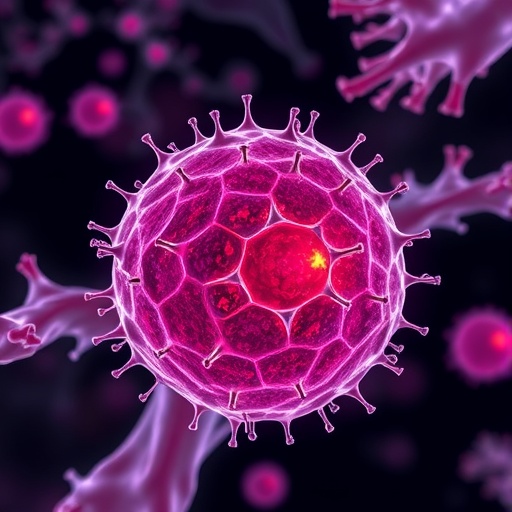In the relentless battle against cancer, metastasis remains the ultimate adversary, responsible for the majority of cancer-related fatalities worldwide. Among the diverse forms of breast cancer, triple-negative breast cancer (TNBC) stands out as particularly aggressive, marked by its absence of estrogen receptor (ER), progesterone receptor (PR), and human epidermal growth factor receptor 2 (HER2). This lack of targets makes TNBC notoriously difficult to treat and prone to early recurrence and rapid metastatic spread. Recent groundbreaking research conducted by a team at the University of Tsukuba in Japan unveils a pivotal mechanism by which TNBC cells manipulate their surrounding environment to accelerate disease progression.
Central to this discovery is the glycoprotein known as Glycoprotein non-metastatic melanoma protein B, or GPNMB. Unlike what its name might suggest, GPNMB is heavily expressed in TNBC cells and directly influences the tumor microenvironment (TME). The TME—a complex and dynamic ecosystem comprising immune cells, stromal elements, and extracellular matrix components—plays a crucial role in determining tumor growth and metastasis. The study reveals that GPNMB modifies this microenvironment by reprogramming macrophages, a type of immune cell, into immunosuppressive tumor-associated macrophages (TAMs). These TAMs then actively support tumor progression rather than combating it.
A fascinating twist in this molecular interplay arises from a cancer-specific modification of GPNMB: its sialic acid modifications. These sugar residues attached to GPNMB allow it to selectively bind to Siglec-9, an immune receptor expressed on macrophages. The Siglec family of receptors is widely recognized for their role in immune regulation, particularly in dampening immune responses. By engaging Siglec-9, GPNMB effectively hijacks macrophages, pushing them towards an immunosuppressive phenotype characteristic of TAMs. This phenotypic shift suppresses anti-tumor immunity and fosters an environment conducive to cancer cell survival and dissemination.
This molecular crosstalk does not act in isolation. The EMT, or epithelial-mesenchymal transition, is a biological process by which epithelial cancer cells lose their adhesion properties and gain migratory and invasive capabilities. The GPNMB-Siglec-9 interaction is shown to enhance EMT, fueling cancer cell motility and invasiveness, thereby promoting metastasis. What is particularly striking is evidence for a self-amplifying loop involving GPNMB. The glycoprotein not only reprograms macrophages but also boosts its own expression within tumor cells, perpetuating and potentially exacerbating this vicious cycle.
Experimental validations of these findings come from rigorous mouse model studies. In these models, blockade of GPNMB or its murine counterpart receptor Siglec-E yielded dramatic reductions in the expression of interleukin-6 (IL-6)—a cytokine pivotal for EMT induction—and concomitantly suppressed metastatic events. This positions the GPNMB-Siglec-9 axis as a critical regulator of tumor progression and underscores its viability as a therapeutic target.
The implications of this research are profound. Current treatments for TNBC are heavily reliant on conventional chemotherapy and radiation, options that frequently fall short because of rapid development of therapeutic resistance. Targeting the crosstalk between tumor cells and immune components presents a novel immunotherapeutic avenue. Therapies designed to interrupt the GPNMB-Siglec-9 interaction could reprogram TAMs from an immunosuppressive to a tumor-fighting phenotype, restoring immune surveillance and slowing metastasis.
On a molecular level, the cancer-specific sialylation of GPNMB represents a particularly attractive target. Drugs or biologics that selectively recognize this modification could achieve high tumor selectivity, minimizing off-target effects. Moreover, since GPNMB engagement with Siglec-9 promotes EMT through IL-6 signaling pathways, combination therapies that also disrupt IL-6 signaling might produce synergistic anti-metastatic effects.
This pioneering research sheds light on the critical influence of tumor-host immune cell interactions in shaping cancer progression. The dynamic remodeling of the TME by TNBC cells, harnessing immune checkpoint-like receptors such as Siglec-9, reflects sophisticated cancer strategies to evade immune attack and enhance dissemination. The identification of GPNMB as both a modulator and amplifier within this context may open the door for biomarker development, allowing stratification of patients most likely to benefit from targeted blockade.
Furthermore, this study exemplifies the importance of post-translational modifications—specifically glycosylation patterns—in modulating protein function in cancer. The cancer-specific sialic acid modification of GPNMB indicates the nuanced ways tumor cells alter molecular interactions to their advantage, beyond genetic mutations alone.
In the broader landscape of cancer immunology, targeting TAM polarization represents a forefront of research and clinical interest. Tumor-associated macrophages often contribute to immune evasion, angiogenesis, and matrix remodeling. The revelation that tumor-expressed factors such as GPNMB can directly influence macrophage phenotype through defined receptor pathways expands opportunities for intervention.
Looking ahead, development of therapeutic antibodies or small molecules capable of blocking the GPNMB-Siglec-9 axis in human patients should be prioritized. Preclinical models should also explore combinatory approaches integrating checkpoints inhibitors, IL-6 antagonists, and agents targeting glycosylation enzymes involved in GPNMB modification. Success in these endeavors could dramatically improve outcomes for patients with TNBC, a subtype in urgent need of innovative treatments.
The convergence of tumor biology, immunology, and glycobiology in this discovery epitomizes the increasingly interdisciplinary effort required to tackle metastatic cancer. By unmasking the GPNMB-Siglec-9-mediated reprogramming of the tumor immune microenvironment, researchers have added a seminal chapter to the ongoing story of understanding and conquering cancer metastasis.
Subject of Research: Mechanisms of tumor microenvironment modulation in triple-negative breast cancer involving GPNMB and Siglec-9 interaction.
Article Title: Tumor-expressed GPNMB orchestrates Siglec-9⁺ TAM polarization and EMT to promote metastasis in triple-negative breast cancer
News Publication Date: 2-Sep-2025
Web References:
https://doi.org/10.1073/pnas.2503081122
Keywords: Breast cancer, Cancer immunology, Cancer stem cells, Cell cultures, Macrophages, Metastasis, Mouse models, Single cell sequencing, Tumor microenvironments




